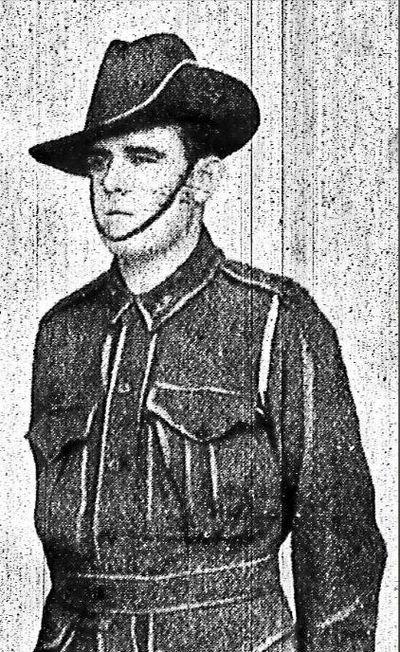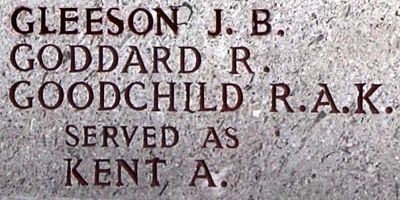Rupert Arthur Kent Goodchild
From Our Contribution
 Western mail 2 Jul 1915 page 1s | |
| Personal Information | |
|---|---|
| Date of Birth | c Jan 1888 |
| Place of Birth | Lutwyche, Brisbane, Queensland |
| Death | 26 Apr 1915 |
| Place of Death | Anzac Cove, Gallipoli, Turkey |
| Age at Enlistment | 27 years, 3 months |
| Description |
5'5" (1.65m) tall ; 136lbs 61.689 kg ; dark complexion ; brown eyes ; dark hair |
| Occupation | Survey hand |
| Religion | Church of England |
| Address | Western Australia |
| Next of Kin | Uncle (later established to be his Father) , Mr. Ernest G. Goodchild |
| Military Information | |
| Reg Number | 639 |
| Date of Enlistment | 21 Sep 1914 |
| Rank | Private |
| Unit/Formation | 16th Battalion, 'B' Company / 4th Brigade, 1st Division |
| Date of Embarkation | 22 Dec 1914 ‒ 1 Feb 1915 |
| Ship Embarked On | HMAT A40 Ceramic Melbourne to Alexandria |
| Fate | Killed in Action 26 Apr 1915 |
| Monument |
Lone Pine Memorial Jarrahdale Honour Roll ANZAC Memorial Park (Byford) |
| Medals |
1914-15 Star British War Medal Victory Medal Medals sent to his father in 1920 to hold in trust for his grandson. |
Contents
[hide]Pre War
Pte Goodchild had previously fathered an ex-nuptial son, known as Arthur George Albert Tondut, born 26 Aug 1907 whom he acknowledged and had made financial provision for via a Court Order (10/- per week). The Mother had subsequently remarried, and the child was raised by maternal grandmother Mrs Ellen Tondut.
War Service
While there are many folios on his file, very few of which give us information in relation to his service. The battalion history "The Old Sixteenth" by Captain C Longmore lists Rupert under his alias of Arthur Kent as an original member of the 16th Battalion's 'B' Company, and as such will have up until his death shared the experiences of his fellow unit members. Two months of training at Blackboy Hill in Perth was followed by travel aboard either SS Indarra or SS Dimboola to Melbourne where all units of the 4th Brigade were assembling at Broadmeadows camp.
Following further training and a march through Melbourne the battalion embarked on HMAT A40 Ceramic at the Railway Pier, Port Melbourne on 22 Dec 1914. A brief stop was made in Albany from 28 - 31 December, before they sailed for Egypt as part of the second convoy comprising 16 transports with their escorts. Alexandria was reached on 1 Feb 1915 via Aden, Suez and Port Said, but disembarkation did not occur until 3 Feb 1915. Once ashore the battalion were entrained for Zeitoun, Cairo and from there by march to Heliopolis on its outskirts. Training resumed until 11 Apr 1915 when the battalion moved by train to Alexandria where they boarded HMT Haida Pascha for Mudross on the island of Lemnos and then late in the afternoon of 25 Apr 195 for Anzac Cove.
Once ashore the battalion began its move uphill to the fighting, with 'B' Company tracking up the Monash and Shrapnel Gullies to take a position that would later be known as 'Pope's Hill. Once there they began to dig in, but later it was evident that the position was under Turkish observation and incessant sniper fire.
On the two different pages of his records are two entries, one stating that Rupert was Killed In Action 26 Apr 1915, and the other that he had Died Wounds on 30 Apr 1915. One of them also contains the entry "(Entries checked and found correct)". The official answer was to be KIA on 26 Apr 1915.
Notes
Several sources of names for the Serpentine-Jarrahdale district include an A. Kent. While there are 10 other Kents with initial A in the A.I.F., none other than Rupert Arthur Kent Goodchild, using it as a pseudonym, has a WA connection that I could find.
On that basis I have included him in the webpage, although his connection (probably to Jarrahdale) is not clear cut. His true identity only became know to military authorities after his death.
Rupert is commemorated on the Lone Pine Memorial (Panel 53), Gallipoli, Turkey. Situated in the Lone Pine Cemetery at Anzac, is the main Australian Memorial on Gallipoli. Designed by Sir John Burnet, the principal architect of the Gallipoli cemeteries, it is a thick tapering pylon 14.3 metres high on a square base 12.98 metres wide. It is constructed from limestone mined at Ilgardere in Turkey.
The Memorial commemorates the 3268 Australians and 456 New Zealanders who have no known grave and the 960 Australians and 252 New Zealanders who were buried at sea after evacuation through wounds or disease. The names of the Australians are listed on a long wall of panels in front of the pylon and to either side. Names are arranged by unit and rank.
The Memorial stands over the centre of the Turkish trenches and tunnels which were the scene of heavy fighting during the August offensive. Most cemeteries on Gallipoli contain relatively few marked graves, and the majority of Australians killed on Gallipoli are commemorated here.

